Jim Reeves
There's something to be said about not having your own room growing up. My last year of high school, my great aunt and uncle decided after 17 years that I should have my own room and swapped their bedroom for my convertible living room couch that I grew up sleeping on.
Being the only kid in a ninety apartment building, I spent a good amount of time with Chas Konnecki, the superintendent's son. He ran the maintenance shop in the huge basement where all the tenant's storage rooms were. There were tons of exotic tools and parts and being curious, Chas taught me all about it. Things that make ninety families happy. I learned about drills and lathes, and grinding wheels and electricity, and switches, all kinds of switches. Chas taught me about fuses and the "new" circuit breakers and how to prime galvanized aluminum for paint preparation. He supervised my customized, built from iron bed frames and wheelbarrow wheels and door hinges and tractor steering mechanismsand household parts go-cart when I was in grammar school.
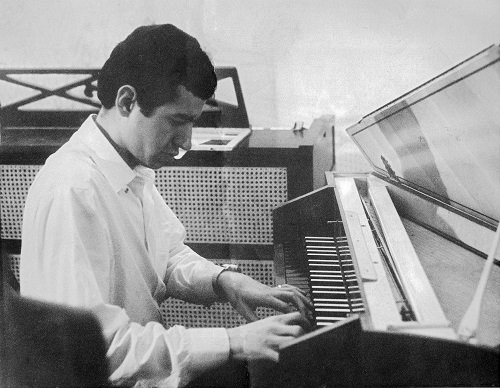
Jim Reeves at Harpsichord Studio. Photo courtesy of Jim Reeves.
And there was also Sam the TV repairman, whom I hovered over when he came to repair our ever breaking Dumont black and white TV. He'd describe the parts in the TV to me as he repaired away, while discussing his divorce from his cheating wife to my aunt and uncle. Sam would say, "You see that? That round yellow thing? That's a capacitor! That holds the electricity in it while other stuff is going on. There's a resistor. All those colored rings on it tell you the value in "ohms". Oh, and that... don't touch that unless you want to die! It has 10,000 volts in it! " The flyback transformer". I'm still freaked about it. Yea, Sam Levinson. The TV repairman.
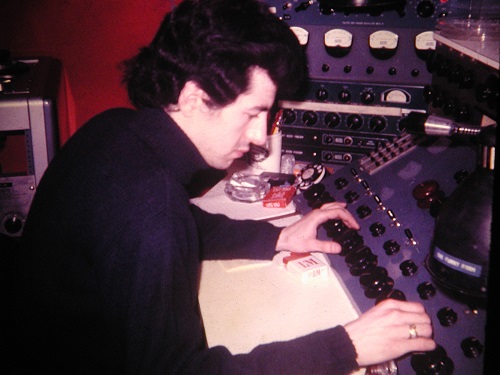
Jim Reeves at Studio 3 - Cisum Mix. Photo courtesy of Jim Reeves.
I had been experimenting with my first tape recorder, hooking it up to the TV speaker in the living room to do my music-minus-one vocal performances. Sort of a '50's karaoke thing. Now, with my own room, I could go crazy, setting up what was to be the advent of my gear ridden life.
It started when I added a second tape machine so I could multiply my vocal parts by recording one vocal on machine one, and then playing it back to machine two while adding a second vocal part. And so on, back and forth till I got several vocal harmony parts done. But, while being incredible to hear yourself doing all the parts yourself, the sound was somewhat hollow because I was using the mic to blend the previous vocal with the new vocal which meant that each previous part was being re-recorded through the mic, which made it more distant and "roomy" sounding. So I decided to build a mixer that would allow me to mix the previously recorded part directly to the second machine while adding the new part to it with the mic. And that is what I did.
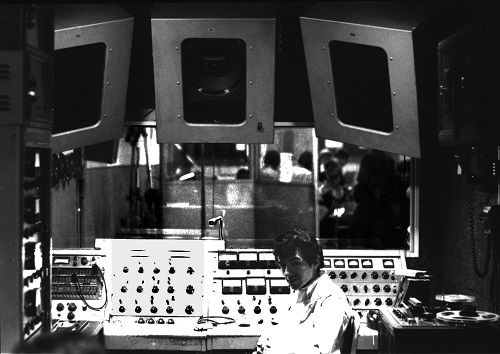
Jim Reeves at Incredible Sounds. Photo courtesy of Jim Reeves.
Between the two Wollensak reel-to-reel tape decks was my home made mixing console. There were no audio schools then, so I was pretty much on my own about making stuff work. It took a lot of experimenting. I was given an unused machine shop in Brooklyn Automotive high school to research and develop it. Cutting and drilling the panels, bending them into shape and wiring it up from scratch.
The mic hanging from my Atlas SB36W ("w" meant it had wheels, man!)boom stand was my first Shure 55s dynamic cardioid mic. The two Wollensak mics that came with the tape recorders were on Atlas MS-10C stands. Under the console were my audio dictionary and glossary and RCA tube manuals. To the right were my 33rpm LP's, and cataloged in album covers were my 78rpm and 45rpm vinyl record collecton, my conga from my trip to Mexico and my Columbia Hi-Fi Stereo phonograph player. It took 2 summers working as a cashier to earn the money to support my dream.
Lori Burton A&R 799 session excerpts 1970. Video courtesy of Jim Reeves.
Letter Of Introduction:
It is difficult to sum up fifty-one years of audio engineering experience in a single page. But after often being asked how I got started in the recording business, I started thinking back. Ever since I can remember, while growing up in Manhattan, dabbling with mechanical and electronic components was a part of me. Gilbert Erector and Chemistry Lab sets, electric trains, construction kits, plastic and balsa wood model airplanes with gasoline engines, co2 propelled racing cars, right up to constructing custom skate boards, go-carts and two story clubhouses right on 2nd Avenue and 62nd street. Early piano lessons from 6 years old became my musical foundation, and my Great Aunt Helen's perpetual harmonizing in my ear led to my vocal involvement in my Doo Wop group at 13 years old and then on to my Jazz harmony big band vocal group, The Progressions, in my late teens.
Me, on baritone and sometimes 2nd tenor and falsesetto, Johnny Fielder, the best 2nd tenor ever, Alex Sczylagyi on 1st tenor, Bob Constantino on perfect pitch bass, and the inimitable Hal Piest on Lead vocals at the Tuxedo Ballroom at 86th street and 3rd Avenue every Sunday Night. Originally the Melodies with Dan Rivera and Mike Kearney.Our 1st place trophy was awarded to us in the competition of the best 30 doo wop groups from the five boroughs of NY. Held at Lenox Hill Neighborhood House in Manhattan in 1962.
I guess the natural progression was to combine my electromechanical and musical talents into constructing my own home recording studio as a base to develop arrangements and record myself and my vocal group.
When I began my career as an engineer, there were no high school or college courses for audio engineering. One knocked on studio reception doors for an interview, and most times never got past a disgruntled voice on an intercom speaker in the halls of the Brill Building. When you did get an interview, you might be asked if you were familiar with an Ampex 300 duplicator deck, or a Neumann M-49, and you would be creative (lie) and say, "Of course, why I practically designed it!" or "That's all I used on my last album!"
But, when I finally got the job working for the guy who built Les Paul and Mary Ford's home studio in the '40's, Dave Sarser (see "Studio 3" below...), and after fetching 8,000 cups of coffee, mopping the floors and cleaning the toilets, and getting to do mic set-ups and editing 30,000~@#$%^!*> dialogue and music cues, and cutting acetates on Neumann, Scully and Fairchild lathes, and moonlighting recording sessions of my own Doo Wop group for auditions for the gigs we got with WMCA and disk jockey Cousin Brucie, I would eventually get thrown into a session here with the Supremes, and there with Johnny Ray and Benny Goodman, and Ruby and the Romantics.
"Not bad..." I thought, "...for a start!" But the studio I was working in, as cool as it was, I felt needed streamlining. So I stayed better "in tune" with these sessions by automating everything I could think of that might have hindered the flow of the previous session, modifying the console, the talk back, playback, cue systems, echo chambers, mic pre's, deck alignments, the room acoustics, and esthetics. By the time Sarah Vaughan and Leslie Gore showed up, I was a lot closer "capturing the moment". I still maintained my own studio at home, just so I could be more involved in developing new production techniques, and my own music.
As my engineering career was growing, and 3 track was becoming obsolete, and tubes were turning into transistors, I was encouraged to become more and more involved in constructing 4 to 8 track studios for clients like Luther Dixon, Eddie Singleton, Jeff Barry (The Monkey's) and Bert Berns of Bang Records (Rickey Derringer & The McCoys/Tommy James & the Shondells/The Young Rascals). I even designed and installed telephone patches in Screen Gems and April Blackwood Music so they could audition songs directly over phone lines (as a result of my technical tutoring from inspirational mentors and knowledge givers, Dave Sarser-Studio 3, Grant Ellerbach of Kapp Records, Penn Stevens and Paul Prestipino at the Record Plant and Eric Porterfield of Columbia Records. I won't forget them).
In the latter half of the 60's, when the "Music Revolution" was beginning, the sound systems in Manhattan clubs were not equipped to handle the heightened energy of the acts that were to follow. I wanted to insure that the artists that I was producing and mixing for had more than adequate sound systems to perform with. I was commissioned to install sound systems in the first Discotheques of the '60's, when Discotheques were unique and had magic. Places like Howard Pratt's, Claude Bell's and Geist Ely's discotheques, Le Club, Ondine and The Barge, and Cybil Burton's Arthur's , Il Mio at Del Monaco, Coney Island Pub, Harlowe's and in clubs like Electric Circus and Steve Paul's The Scene, where I was also hired as chief discaire (D.J) and handled the stage managing and sound (what there was of it then) for guys who played there, like Hendrix and The Doors, Joplin, Buffalo Springfield, The Druids of Stonhenge (still going strong today), The Denims, The Losers, The Pilgrims and The Rascals (way before Fillmore East).
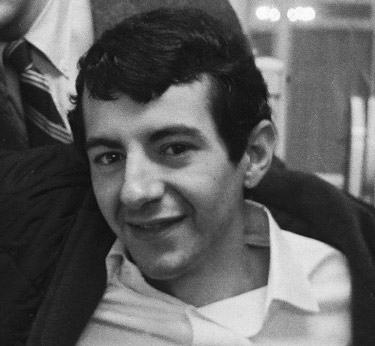
Jim Reeves in 1957.
My Control Room in 1964:
I moved into my first apartment. A newly renovated walkup. Naturally, I got the top floor studio apartment. The fifth floor, which was leagaly the max height before an elevator would have to be put in.
My first Shure 55s dynamic cardiod mic hanging from my Atlas boom stand had long been sold to my first client/friend Butch Giacomontonio. My first apartment on 89th Street in Manhattan was now the home of my new custom made console which was as close a replica of Dave Sarser's Pultec Blue Console as I could make. The panel was made from a discarded Burrough's Business Machine's computer desktop that I brought to my old high school's machine shop (at Brooklyn Automotive). I cut and folded it, drilled it out and built a plywood cabinet for it. I was eventually able to get the components for my console on Courtland Street in downtown Manhattan, famous for old army surplus radio parts (cheap). I got the Allen Bradley pots and RCA industrial knobs, 3 position toggle switches and Graybar telephone type pushbutton switches there after much scrounging. I wired it up, added the tube preamplifiers that I got from Dave Sarser as salary for engineering my first project for him, and cloned additional pre-amps from those, that I constructed and wired myself. They served as the console's summing amps and program amps and were mounted beneath the panel that I painted Burrough's Blue, (kinda' like "Pultec Blue"-ish) from spray paint I got from working at Burroughs Business Machines. The audio patch bay was made from what was formally an old video patchbay discarded from Metromedia's television studios (Channel 5 TV NY). It had been replaced with a new one and was being thrown out. I ws there at just the right time. Just as they were about to toss it, I took it to Channel 5's mail room, packed it up and mailed it to myself.
When it arrived at my house I rewired it for audio, attached a piano hinge to one end of it to turn it into a door so I could access it for servicing. I built a plywood cabinet around it. I kept my homemade console tube mic pre-amps and power supplies that I made, inside the patchbay cabinet. I discovered through my friend, Doug Weber, a colleague from Channel 5, my Eico Master Control pre-amplifiers. They had extreme tonal range control and served as my outboard tube equalizers. They sat on the shelves above the console and supported my Weston VU Meters that I mounted in an aluminum chassis.
On the shelf above that was my self-built Dyna-Kit power amplifier. And the prototype experimental amplifier chassis used by Fisher to develop their X-101 amplifier. Dave got it for me for $10. It served as the studio playback amp. The shelf just above the console held my Empire Troubador Dynamic belt driven turntable, my Electrovoice shotgun mic, and my 45rpm collection.
Above the patchbay cabinet was my American Concertone 505 reel to reel tape recorder that Dave got me from trumpeter Bobby Hackett. It sat on the shelf next to my Eico reel to reel tape recorder.
The 4 stepped attenuators for the meters were just beneath the Concertone deck. My Heathkit oscilloscope and RCA vtvm calibration and test equipment was at the right of the patchbay. My "hot-rodded" Eico 377 sine and square wave audio generator was atop the Concertone.
When my downstairs neighbors, Ted and Betty moved out of their leased apartment a month early, they left me their keys and a supply of Betty's peach cobbler. I flew my mic cables out the window into their vacant apartment and called Butch's brother, Mickey Gee and the G 3 and had my first very own, full blown, independent, split-level album session in Ted and Betty's place at 252 East 89th Street in Manhattan in 1964.
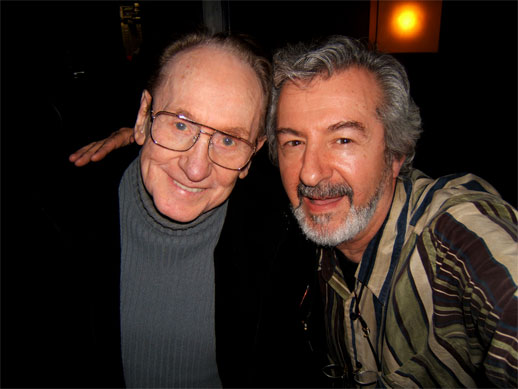
Jim Reeves and Les Paul at the Iridium in New York.
Later in the `60's:
Twenty albums, five studios i.e., Studio 3, Talentmasters, IncredibleSounds, Le Studio, Jaysina, A-1 Sound, Regent, Kapp, and eight years of engineering later, while producing two groups for United Artists (Dream Spectrum) and Epic Records (Phil Galdston's CISUM) at CBS, V.P. John McClure set up an interview for me when a staff engineer position opened at Columbia Records. CBS did hire me with a certain enthusiasm that I won't forget. They asked me to splice (razor blade edit)some tape recorded music together. My g-zillions of prior editing experiences paid off in a big way.
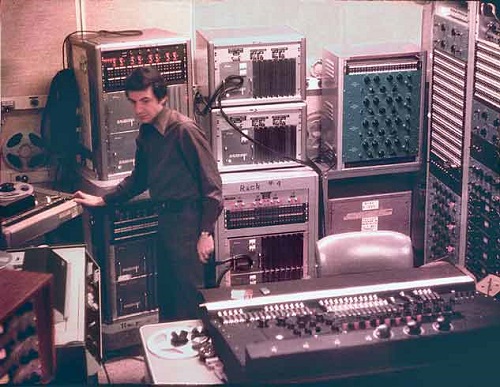
Jim Reeves making first "Released" Dolby Recording in History.
Room 409 at CBS NYC, 1969:
So you make their records for them, why not? You want to help Bobby Vinton make a hit record, don't you?...and Johnny Winter (and...Live) and Edgar Winter (Free Ride), and George Harrison/Bob Dylan/Peter Asher, and talent like that. And with everything you and Columbia Records, with their sophisticated technology, can offer, in order that they may compete in the world marketplace, you do it! What a great timeto be in it. Meanwhile Gregg Allman (Laid Back), Mott the Hoople (live at the Uris Theatre), Lou Reed (Berlin), Martin Mull and ZZ Top's (Fandango) managers started calling and wanted me to engineer their albums. That was when I discovered the Record Plant Recording Studios. A new wave of recording environments. Here's an engineer's dream: super talented artists, plus technological sophistication in studios, neatly tying a home environment to state-of-the-art electronics. And then they even put one in a truck(!)...which one would be glad to manage and engineer out of, for three or four years. So I did just that. Around 1975, I was approached by a New York nightclub entrepreneur, Jimmy Pullis, (aka JP, who I had first met outside Ondine hawking Timothy Leary albums under both arms). He commissioned me to install a hi-tech sound stage in his club, audition and book live acts as "candidates" for the record labels. So I took it another step and designed his club, "JP's", as a night club with a recording studio environment with a great monitoring and lighting system, and some video gear too. And it turns out to be a fantastic place for Bonnie Raitt, Phoebe Snow, James and Carly, Dave Mason, Dickie Betts, Manhattan Transfer, Peter Framton, Jimmy Buffett, Stevie Goodman and Billy Joel, John Bellushi, Bill Murray to jam (to mention a few).
And later we did a place called "TRAXX" on 72nd Street and Columbus Avenue. During its constuction period, while on my way to the club, I heard my name being called. "Jim ...Jim ". It was John lennon, with whom we had established a relationship at the Record Plant. I first introduced John Lennon to the club right then, brought him in and gave him the tour, itroduced him to the workers and left him with an invitation to hang out at his leasure as he was right down the street at the Dakota. He loved having a place to mingle among friends in the music world. That was our last meeting. But, at our JP's reunion 2011, May Pang let me know they had visited often.
The club turned out to be a sensational venue and so I made a little history... and then, I ended up going out on the road with these guys, all over the world, mixing in 24,000 seat convention centers.
Then, independent jingle composer, Edd Kalehoff came into the picture and asked if I was interested in co-producing jingles. What engineer doesn't crave string and horn dates, tons of background singers, choruses, synths, midi sequencers, all locked to video, recording 20 to 50 piece orchestras daily? Or starting at nine in the morning with a piano road map and click track, then overdubbing the rhythm section, harp, tympani, percussion, background and lead vocals, voice-overs, and by six you've mixed ten 30 second spots to be aired nationally on the Super Bowl the next day and get residuals five days a week for five years? As well as managing his 24 track recording facility. You'd probably amuse his offer and go for it. I graciously accepted Edd's offer. Finally, a great job, with income! I also got to produce some bands there.
Then...In 1983, having two kids, who tend to rewrite the script for you, I moved to Westchester N.Y. and built a studio in my house... and my own clientele to match. And for eight years I worked with New York-based composer/musician/producer types, producing jingles, albums, t.v. themes, composing on computer based midi sequencers locked to the tape transport for the analog stuff, and it's going great. By the '90's my wife got homesick for Illinois, and sick of me too, so we moved near her home town of Winnetka, to Wilmette while the boys got their act together.
In 1993, I bought a renovated building that used to house the Jung Institute. I constructed Reeves Audio Recording in it. It's in the southeast end of Evanston, Illinois, just north of Rogers Park. It's now an all digital 64 track Pro Tools HD8 MAC TDM Total Recall hard disc recording facility, and AVID Media Composer MAC non-linear video recording and editing has been added with lots of automation to keep the music flowing. Now I'm even making music videos. I am still loving the creating of music and occasionally even get to sing some doo-wop.
Yours truly,
Jim Reeves, Audio Engineer/Audio Consultant/Producer/Composer/Musician/Singer/Maintenance Engineer/AKA-Recording Product Helper
Foundational text courtesy of Jim Reeves.
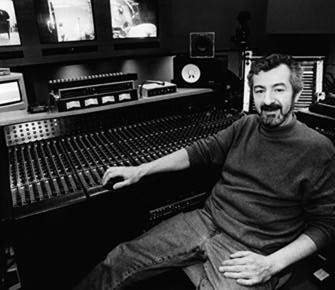
Jim Reeves at Reeves Audio Recording.
Write about Jim Reeves!
Do you have content or pictures, to add, of Jim Reeves? Do you just want to say "Hello!"? Please feel free to Share it, here!
What other Visitors have said about Jim Reeves!
Click below to see contributions from other visitors to this page...
Hi There Not rated yet
Hi Jimmy,
Remembering the Good times at Dr. Generosity’s on upper east side.
Mindy
Return from Jim Reeves to Recording Engineers, Producers and Associated Recording Industry Professionals
|


